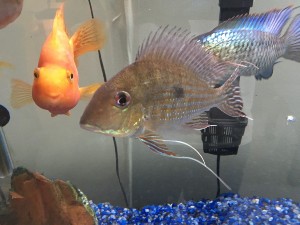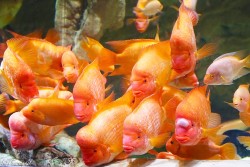Geophagus altifrons (Tapajos Orange Head) Breeding Care, Size, Species, For Sale
 Geophagus altifrons, commonly known as the "Red Head Tapajos" or "Orinoco Eartheater," is a striking and captivating tropical fish species that has captured the hearts of aquarium enthusiasts around the world. With its distinctive red-hued head, intricate patterns, and engaging behavior, Geophagus altifrons is a popular choice among aquarists seeking to create a vibrant and dynamic aquatic environment. Native to South America, specifically the Orinoco and Tapajos river basins, this species thrives in a carefully maintained aquarium setup and offers both aesthetic beauty and intriguing social dynamics to those who choose to keep it as a part of their aquatic community. In this introduction, we will delve into the fascinating world of Geophagus altifrons, exploring its characteristics, care requirements, and the joy it brings to aquarists seeking a unique addition to their tanks.
Geophagus altifrons, commonly known as the "Red Head Tapajos" or "Orinoco Eartheater," is a striking and captivating tropical fish species that has captured the hearts of aquarium enthusiasts around the world. With its distinctive red-hued head, intricate patterns, and engaging behavior, Geophagus altifrons is a popular choice among aquarists seeking to create a vibrant and dynamic aquatic environment. Native to South America, specifically the Orinoco and Tapajos river basins, this species thrives in a carefully maintained aquarium setup and offers both aesthetic beauty and intriguing social dynamics to those who choose to keep it as a part of their aquatic community. In this introduction, we will delve into the fascinating world of Geophagus altifrons, exploring its characteristics, care requirements, and the joy it brings to aquarists seeking a unique addition to their tanks.Common names
Geophagus altifrons is known by several common names including the humphead cichlid, high-bodied eartheater, and Orinoco eartheater.Etymology
The genus name Geophagus means "earth eater" referring to these cichlids that sift sediments. The species name altifrons comes from Latin meaning "high forehead".Classification
Geophagus altifrons is classified within the family Cichlidae. It is grouped in the genus Geophagus which contains many Neotropical eartheater cichlids.Distribution
This species comes from South America where it inhabits river basins in Venezuela, Guyana, and Brazil.Habitat
Geophagus altifrons lives amongst roots in slow-moving rivers, floodplains, streams, and swampy forests of the Orinoco basin.Maximum Standard Length
In nature, Geophagus altifrons can grow to around 19 cm (7.5 inches) in length. Captive fish are typically 12-15 cm (5-6 inches).Aquarium Size
These cichlids require at least a 70 gallon aquarium given their adult size and group-dwelling nature.Maintenance
Weekly 25% water changes, gravel vacuuming, and filter cleanings are recommended along with testing water parameters.Water Conditions
G. altifrons does best in soft acidic water with a pH of 5.5-7.0, temperature of 23-27°C (73-81°F) and low conductivity.Diet
In the wild they forage on aufwuchs, worms and crustaceans. Captive fish accept quality flakes, pellets along with frozen and live foods.Behaviour and Compatibility
Peaceful and ideal for community tanks when kept in groups. Suitable tankmates include other South American cichlids.Sexual Dimorphism
Males are larger and develop elongated filaments on the dorsal, anal, and ventral fins. Females gain increased gold speckling.Reproduction
Geophagus altifrons form monogamous pairs and display bi-parental care. Fry are slow growing but will eat fine foods.Endangered List
Geophagus altifrons is listed as Least Concern and stable in the wild by the IUCN Red List.Geophagus altifrons for sale (Rio Xingu) online with expedited shipping. Shop our extensive listings for South American cichlids now! A member of the family Cichlidae, it can grow up to 22.5 cm (8.9 in) in standard length. It is benthophagous by nature, taking mouthfuls of substrate (hence its common name) and sifting for edible items, with the remaining materials being expelled via the mouth and gill openings. It prefers clear and blackwater environments as opposed to turbid white waters.
The species is a mouth-brooder, meaning it protects the young fry in the mouth. The genus name 'Geophagus' means 'eartheater' which refers to its habit of sifting through the substrate as it searched for food. Its impact on the native ecology is unknown; introduction of non-native species to any water body is not to be encouraged as this can prove disastrous to native fish species which may be out-competed.

South American Biotope - Geophagus altifrons
References
Geophagus altifronsPossibly the most magnificent looking Eartheater.
Geophagus altifrons "Tapajos" is an easy-to-keep cichlid.





